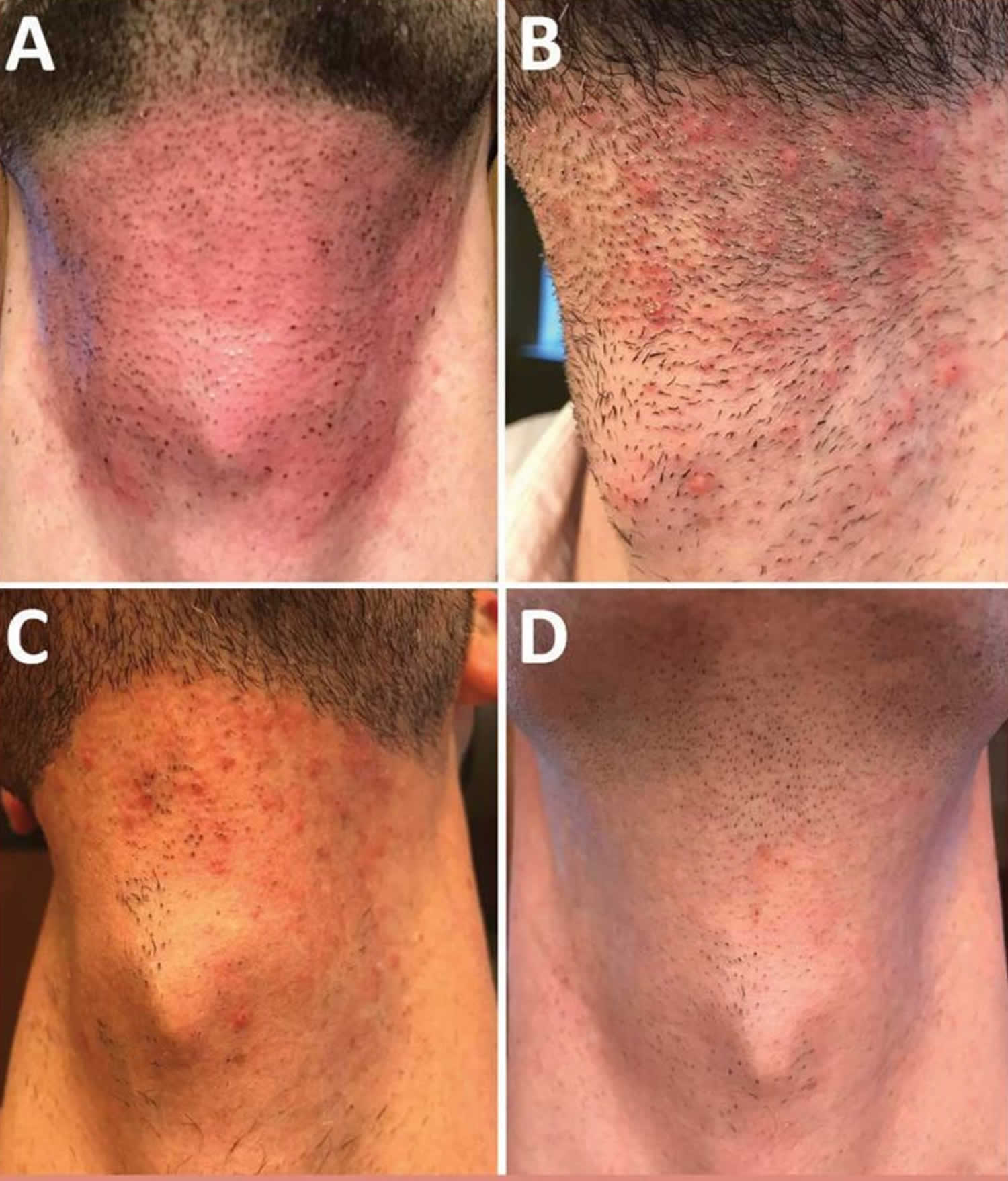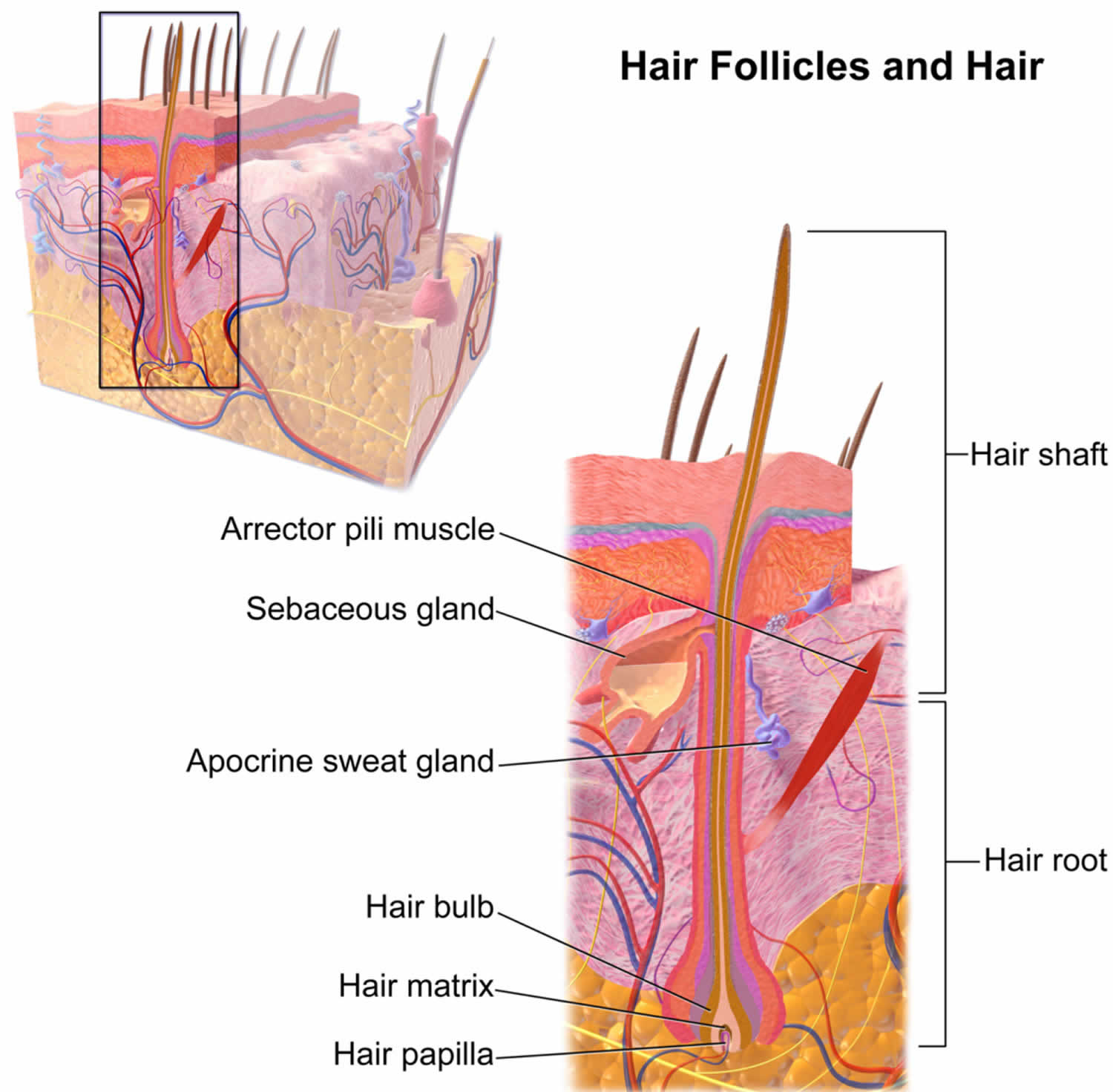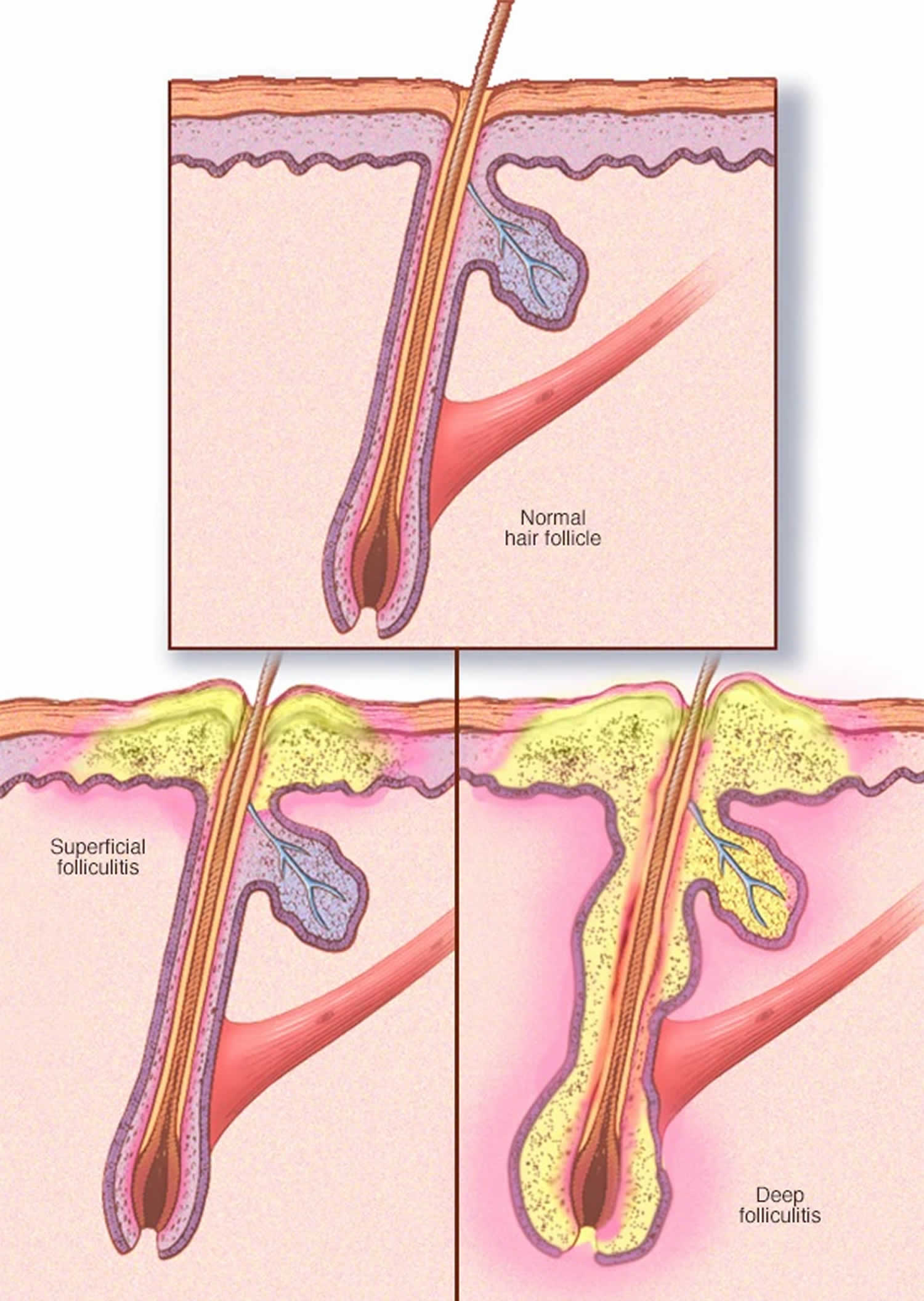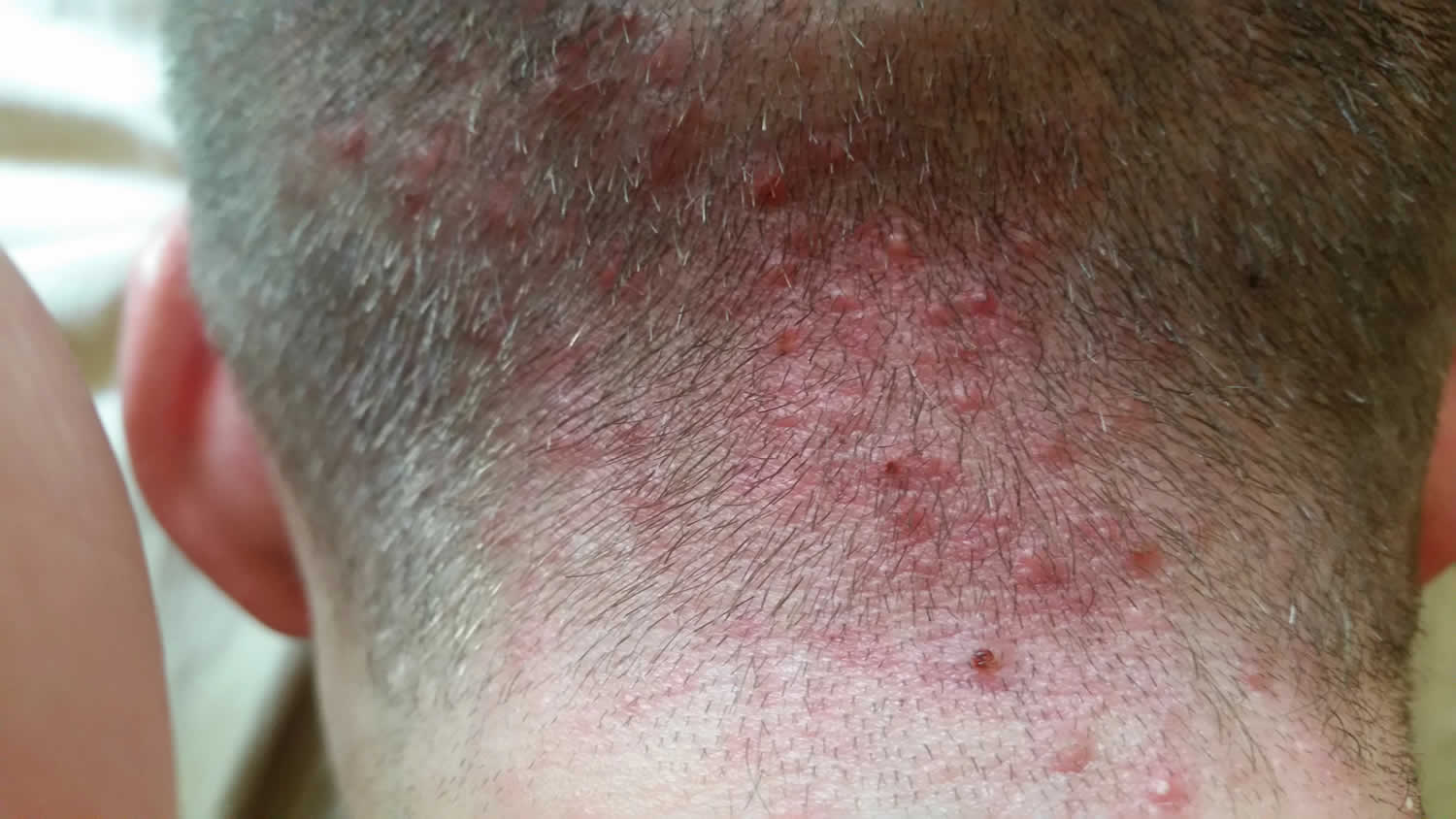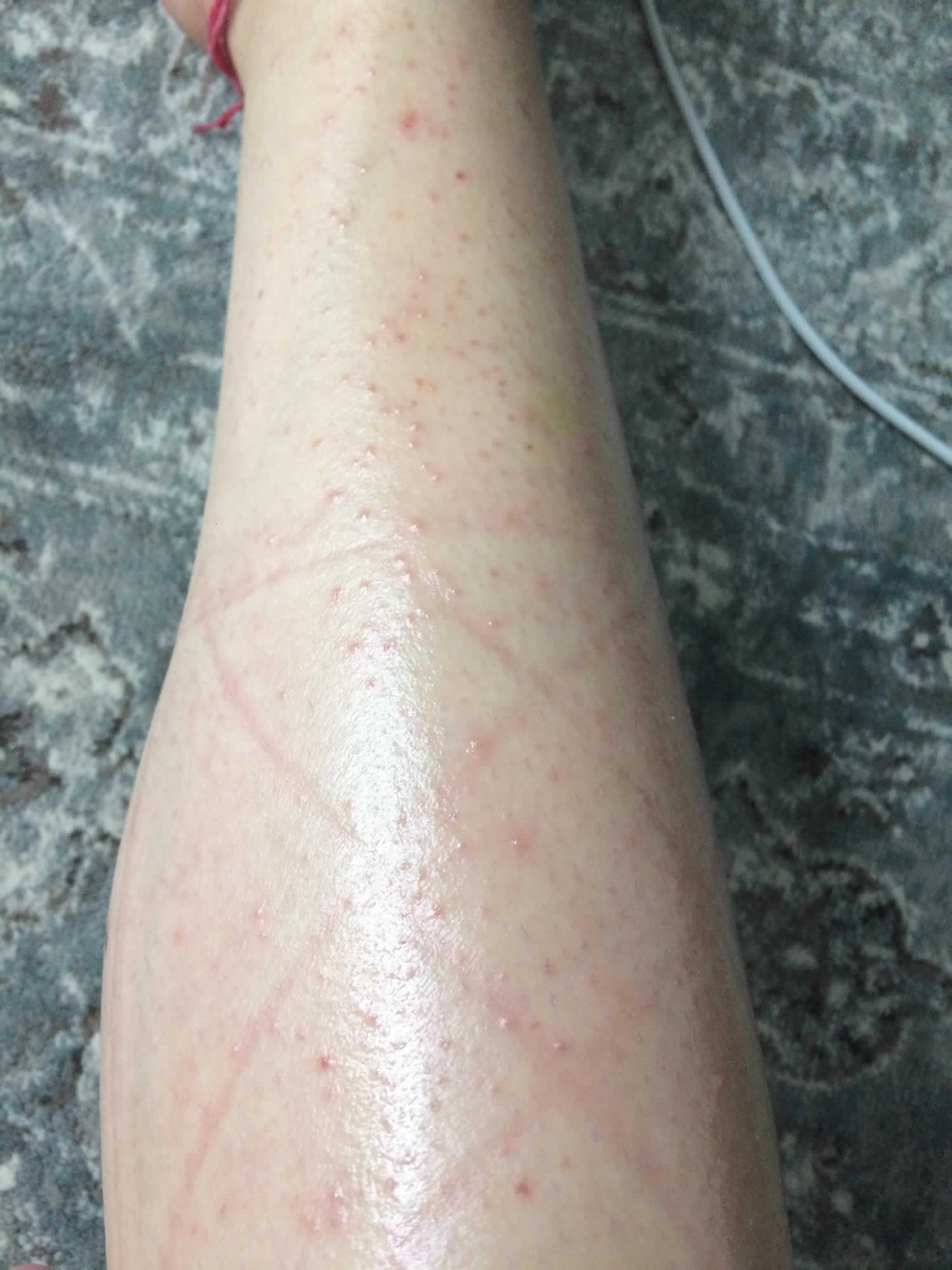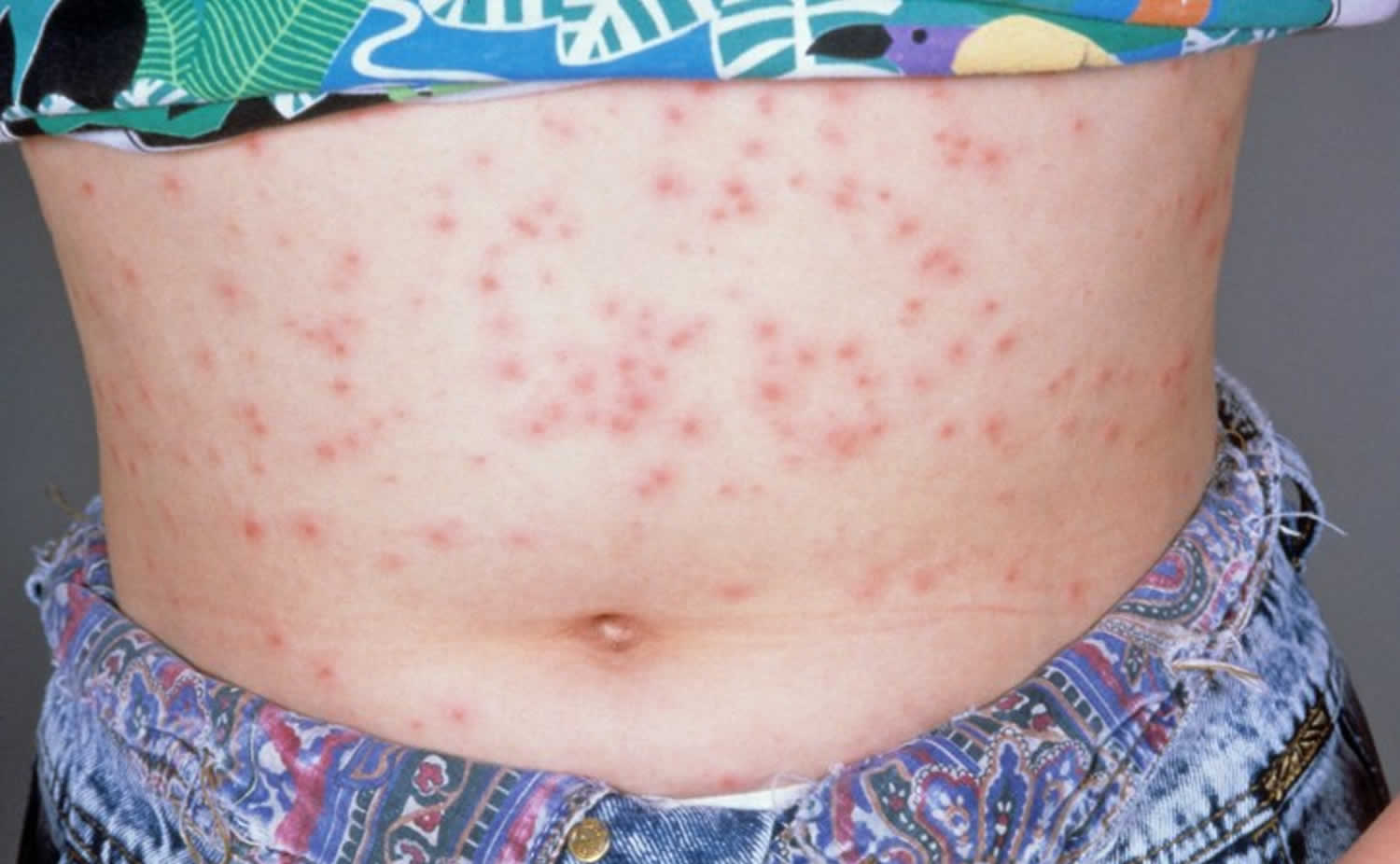Irritated hair follicles
Irritated hair follicles also known as folliculitis, is the term given to a common group of skin conditions in which there are inflammation of the hair follicles. There are many different types of irritated hair follicles, but all are marked by inflammation (swelling), infection or irritation of the hair follicle (a space within the skin that holds the root of a hair and the oil glands) (see Figure 1). When these follicles become infected or irritated, redness, irritation, itching and bumps can develop. The result is a tender red spot, often with a surface pustule. Acne and its variants are also types of folliculitis. Each hair on your body grows out of a tiny pouch called a follicle. Irritated hair follicles or folliculitis may be superficial or deep. Irritated hair follicles can affect any part of your body that has hair, including the beard area, chest, upper back, buttocks, arms and lower legs.
Hair follicles are densest on your scalp, and they occur everywhere on your body except your palms, soles, lips and mucous membranes.
Folliculitis is most often caused by an infection of hair follicles with Staphylococcus aureus (staph) bacteria. Folliculitis may also be caused by viruses, fungi and even an inflammation from ingrown hairs.
You get folliculitis when you damage your hair follicles. Once damaged, it’s easy for germs to get inside the follicles and cause an infection. A common source of infection is Staphylococcus aureus, which is found on your skin. Other organisms on your skin can also cause an infection.
You can damage your hair follicles by:
- Touching or rubbing your skin frequently
- Wearing tight clothing
- Having skin rub against skin
- Shaving
When your skin is damp and hot, it’s easier to damage your hair follicles and get an infection. This can happen when tight clothing rubs against your skin while you’re bicycling on a hot day.
The damage can also happen while you’re using a hot tub or whirlpool. When this occurs, the acne-like breakouts tend to appear on skin that was covered by your bathing suit. Most people see breakouts about 12 to 48 hours after using the hot tub.
While many things can damage your hair follicles, the following are common causes of folliculitis:
- Hot tub (improperly maintained)
- Shaving, plucking, or waxing
- Tight clothing or equipment
- Medication applied to the skin, such as coal tar
- Medication you take
- Weight gain
When hair follicles are damaged, they may be invaded by viruses, bacteria and fungi, leading to infections such as folliculitis. Superficial folliculitis affects the upper part of the hair follicle and the skin directly next to the follicle. Deep folliculitis affects the deeper portion of the follicle and can involve the entire hair follicle.
Forms of superficial folliculitis include:
- Bacterial folliculitis. This common type is marked by itchy, white, pus-filled bumps. It occurs when hair follicles become infected with bacteria, usually Staphylococcus aureus (staph). Staph bacteria live on the skin all the time. But they generally cause problems only when they enter your body through a cut or other wound.
- Hot tub folliculitis (pseudomonas folliculitis). With this type you may develop a rash of red, round, itchy bumps one to two days after exposure to the bacteria that causes it. Hot tub folliculitis is caused by pseudomonas bacteria, which is found in many places, including hot tubs and heated pools in which the chlorine and pH levels aren’t well-regulated.
- Razor bumps (pseudofolliculitis barbae). This is a skin irritation caused by ingrown hairs. It mainly affects men with curly hair who shave too close and is most noticeable on the face and neck. People who get bikini waxes may develop barber’s itch in the groin area. This condition may leave dark raised scars (keloids).
- Pityrosporum folliculitis. This type produces chronic, red, itchy pustules on the back and chest and sometimes on the neck, shoulders, upper arms and face. This type is caused by a yeast infection.
Forms of deep folliculitis include:
- Sycosis barbae. This type affects males who have begun to shave.
- Gram-negative folliculitis. This type sometimes develops if you’re receiving long-term antibiotic therapy for acne.
- Boils (furuncles) and carbuncles. These occur when hair follicles become deeply infected with staph bacteria. A boil usually appears suddenly as a painful pink or red bump. A carbuncle is a cluster of boils.
- Eosinophilic folliculitis. This type mainly affects people with HIV/AIDS. Signs and symptoms include intense itching and recurring patches of bumps and pimples that form near hair follicles of the face and upper body. Once healed, the affected skin may be darker than your skin was previously (hyperpigmented). The cause of eosinophilic folliculitis isn’t known.
Though in many cases folliculitis or acne-like breakouts is not serious and go away on their own within a short time, if you have a healthy immune system and stop doing what caused the folliculitis. However, severe cases may need medical treatment. If folliculitis is spreading, or if there are firm, painful or draining bumps, see your doctor as soon as possible.
To clear your skin more quickly and get relief, apply warm compresses to the area. When using warm compresses, dermatologists recommend that you:
- Apply a warm compress at least 3 to 4 times a day.
- Leave the compress on your skin for 15 to 20 minutes each time.
If a warm compress helps you feel more comfortable, you can apply it more than 4 times a day.
When shaving, plucking, or waxing causes the infection, you’ll want to stop doing these things for 30 days.
Depending on your situation and frequency of recurrences, your doctor may suggest controlling bacterial growth in your nose with a five-day regimen of antibacterial ointment and using a body wash with chlorhexidine (Hibiclens, Hibistat). Further study is needed to prove the effectiveness of these steps.
Figure 1. Hair follicles
Figure 2. Folliculitis
Figure 3. Irritated hair follicle on scalp
Figure 4. Irritated hair follicles on legs
Figure 5. Hot tub skin irritation (hot tub folliculitis)
Make an appointment with your doctor if your condition is widespread or the signs and symptoms don’t go away after a few days. You may need an antibiotic or an antifungal medication to help control the condition.
Irritated hair follicles types
The types of folliculitis include the following:
- Staphylococcus aureus folliculitis: Infection of the hair follicle with Staphylococcus aureus bacteria is one of the most common causes of folliculitis. Small red or white pus-filled pimples can be seen on the skin. The affected area often resolves (gets better) within a few days and can be cared for at home. In severe cases, however, folliculitis should be treated by a medical professional.
- Pseudomonas aeruginosa (“hot tub”) folliculitis also known as spa pool folliculitis, jacuzzi folliculitis or pseudomonas folliculitis: Hot tub folliculitis is a skin infection of the hair follicles that appears after coming into contact with bacteria contaminated water. Hot tub folliculitis is caused by the bacteria Pseudomonas aeruginosa thrives in heated, moving water such as hot tubs, whirlpools and waterslides. Children tend to be affected more often than adults. Pseudomonas aeruginosa can infect the hair follicle and cause a rash that looks a great deal like the one caused by the staphylococcal bacteria. Sometimes the rash is itchy. Hot tub folliculitis typically fades on its own within a few days, but some patients may need medical treatment.
- Malassezia folliculitis: Malassezia are a family of yeast that can normally be found on the skin. Sometimes, when Malassezia gets into the hair follicles, it can cause an itchy condition that looks like an acne breakout, usually on the upper chest and back. This form of folliculitis is aggravated (made worse) by sweat. Using an antidandruff shampoo every day to wash the affected areas of skin is often helpful.
- Pseudofolliculitis barbae: Pseudofolliculitis barbae also called “razor bumps,” Pseudofolliculitis barbae usually occurs in the beard area. After beard hairs are cut with a razor, sharply trimmed edges can turn back into the skin, causing irritation. Pseudofolliculitis barbae is more common in people with curly hair, particularly African-American men.
- Sycosis barbae: Sycosis barbae is a severe, potentially scarring form of shaving-related folliculitis. The entire hair follicle is infected, resulting in large red pustules.
- Gram-negative folliculitis: Gram-negative folliculitis can occur after prolonged antibiotic use to treat acne. Over time, resistant bacteria grow and multiply, resulting in worsening acne.
- Boils (furuncles): Boils, or furuncles, occur when the hair follicle becomes deeply infected. The boil is often red, tender and painful. It will come to a head after several days and may leave a scar behind.
- Carbuncles: A carbuncle forms when several boils appear in one spot. Carbuncles are usually larger and are the combination of multiple infected hair follicles.
- Eosinophilic folliculitis: Eosinophilic folliculitis is usually seen in patients who are immunosuppressed (the immune system is not fully functioning). There is also a form that is seen in babies. Eosinophilic folliculitis is not infectious. It is characterized by itchy pustules, most often on the shoulders, upper arms, neck and forehead.
Irritated hair follicles causes
Irritant folliculitis can be due to infection, occlusion (blockage), irritation and various skin diseases.
Irritated hair follicles due to infection
Swabs should be taken from the pustules for cytology and culture in the laboratory to determine if folliculitis is due to an infection.
Bacterial folliculitis
Bacterial folliculitis is commonly due to Staphylococcus aureus. If the infection involves the deep part of the follicle, it results in a painful boil. Bacterial folliculitis affects children and adults, with adolescents and young adult males most often infected. Recommended treatment includes careful hygiene, antiseptic cleanser or cream, antibiotic ointment, or oral antibiotics.
Spa pool folliculitis also known as Pseudomonas folliculitis, is due to infection with Pseudomonas aeruginosa bacteria, which thrives in inadequately chlorinated warm water. Spa pool folliculitis is a skin condition that arises within hours to a few days after bathing in warm water, e.g., in a spa pool, jacuzzi or warm water swimming pool. It may affect several individuals within 8 hours to 5 days of exposure. However, some exposed individuals do not develop the infection. A similar rash may occur from wearing a wet suit that has not been thoroughly washed and dried after previous use. Most of the time, Pseudomonas folliculitis goes away on its own in 7 to 10 days.
Gram-negative folliculitis is a pustular facial eruption also due to infection with Pseudomonas aeruginosa or other similar organisms. When it appears, it usually follows tetracycline treatment of acne but is quite rare.
Yeasts folliculitis
The most common yeast to cause a folliculitis is Pityrosporum ovale, also known as Malassezia. Malassezia folliculitis (Pityrosporum folliculitis) is an itchy acne-like condition usually affecting the upper trunk of a young adult. Treatment includes avoiding moisturisers, stopping any antibiotics and topical antifungal or oral antifungal medication for several weeks.
Candida albicans can also provoke a folliculitis in skin folds (intertrigo) or the beard area. It is treated with topical or oral antifungal agents.
Fungi folliculitis
Ringworm of the scalp (tinea capitis) usually results in scaling and hair loss, but sometimes results in folliculitis. Cat ringworm (Microsporum canis) is the commonest organism causing scalp fungal infection. Other fungi such as Trichophyton tonsurans are increasingly reported. Treatment is with oral antifungal agents for several months.
Viral folliculitis
Folliculitis may be caused by the herpes simplex virus (HSV). This tends to be tender and resolves without treatment in around ten days. Severe recurrent attacks may be treated with aciclovir and other antiviral agents.
Herpes zoster (the cause of shingles) may also present as folliculitis with painful pustules and crusted spots within a dermatome (an area of skin supplied by a single nerve). It is treated with high-dose aciclovir.
Molluscum contagiosum, common in young children, may also cause follicular umbilicated papules, usually clustered in and around a body fold. Molluscum may provoke dermatitis.
Parasitic folliculitis
Folliculitis on the face or scalp of older or immunosuppressed adults may be due to colonisation by hair follicle mites (demodex). This is known as demodicosis.
The human infestation, scabies, often provokes folliculitis, as well as non-follicular papules, vesicles and pustules.
Irritated hair follicles due to irritation from regrowing hairs
Folliculitis may arise as hairs regrow after shaving, waxing, electrolysis or plucking. Swabs taken from the pustules are sterile — there is no growth of bacteria or other organisms. In the beard area irritant folliculitis is known as pseudofolliculitis barbae.
Irritant folliculitis is also common on the lower legs of women (shaving rash). It is frequently very itchy. Treatment is by stopping hair removal, and not beginning again for about three months after the folliculitis has settled. To prevent reoccurring irritant folliculitis, use a gentle hair removal method, such as a lady’s electric razor. Avoid soap and apply plenty of shaving gel, if using a blade shaver.
Irritated hair follicles due to contact reactions
Occlusion folliculitis
Paraffin-based ointments, moisturizers, and adhesive plasters may all result in a sterile folliculitis. If a moisturizer is needed, choose an oil-free product, as it is less likely to cause occlusion.
Chemicals folliculitis
Coal tar, cutting oils and other chemicals may cause an irritant folliculitis. Avoid contact with the causative product.
Topical steroids folliculitis
Overuse of topical steroids may produce a folliculitis. Perioral dermatitis is a facial folliculitis provoked by moisturizers and topical steroids. Perioral dermatitis is treated with tetracycline antibiotics for six weeks or so.
Irritated hair follicles due to immunosuppression
Eosinophilic folliculitis is a specific type of folliculitis that may arise in some immune-suppressed individuals such as those infected by human immunodeficiency virus (HIV) or those who have cancer.
Irritated hair follicles due to drugs
Folliculitis may be due to drugs, particularly corticosteroids (steroid acne), androgens (male hormones), adrenocorticotrophic hormone (ACTH), lithium, isoniazid (INH), phenytoin and B-complex vitamins. Protein kinase inhibitors (epidermal growth factor receptor inhibitors) and targeted therapy for metastatic melanoma (vemurafenib, dabrafenib) nearly always result in folliculitis.
Irritated hair follicles due to inflammatory skin diseases
Certain uncommon inflammatory skin diseases may cause permanent hair loss and scarring because of deep-seated sterile folliculitis. These include:
- Lichen planus
- Discoid lupus erythematosus
- Folliculitis decalvans
- Folliculitis keloidalis.
Treatment depends on the underlying condition and its severity. A skin biopsy is often necessary to establish the diagnosis.
Acne variants
Acne and acne-like or acneform disorders are also forms of folliculitis. These include:
- Acne vulgaris
- Nodulocystic acne
- Rosacea
- Scalp folliculitis
- Chloracne.
The follicular occlusion syndrome refers to:
- Hidradenitis suppurativa (acne inversa)
- Acne conglobata (a severe form of nodulocystic acne)
- Dissecting cellulitis (perifolliculitis capitis abscedens et suffodiens)
- Pilonidal sinus.
Treatment of the acne variants may include topical therapy as well as long courses of tetracycline antibiotics, isotretinoin (vitamin-A derivative) and in women, antiandrogenic therapy.
Buttock irritated hair follicles
Folliculitis affecting the buttocks is quite common in males and females.
- Acute buttock folliculitis is usually bacterial in origin (like boils), resulting in red painful papules and pustules. It clears with antibiotics.
- Chronic buttock folliculitis does not often cause significant symptoms but it can be very persistent. Although antiseptics, topical acne treatments, peeling agents such as alpha-hydroxy acids, long courses of oral antibiotics and isotretinoin can help buttock folliculitis, they are not always effective. Hair removal might be worth trying if the affected area is hairy. As regrowth of hair can make it worse, permanent hair reduction by laser or intense pulsed light (IPL) is best.
Risk factors for developing irritated hair follicles
Anyone can develop folliculitis. But certain factors make you more susceptible to the condition, including:
- Having a medical condition that reduces your resistance to infection, such as diabetes, chronic leukemia and HIV/AIDS
- Having acne or dermatitis
- Taking some medications, such as steroid creams or long-term antibiotic therapy for acne
- Being a male with curly hair who shaves
- Regularly wearing clothing that traps heat and sweat, such as rubber gloves or high boots
- Soaking in a hot tub that’s not maintained well
- Causing damage to hair follicles by shaving, waxing or wearing tight clothing
Irritated hair follicles prevention
Folliculitis infections largely involve bacteria, germs and yeast entering the hair follicles. You can prevent and lessen the impact of folliculitis by:
- Keeping your skin clean and if dry, well moisturized it.
- Taking care while shaving. Minimize shaving and waxing. When shaving, use a new blade each time and moisturize the skin afterwards.
- Ensure adequate sterilization of hot tubs. Check the chemical disinfectant levels of hot tubs and heated pools before using them.
- Washing off and removing your bathing suit or wetsuit when you get out of a hot tub after each use and let it dry. Washing your bathing suit after each use and letting it dry completely before wearing it helps to reduce your exposure to bacteria that can cause folliculitis.
- Do not wear tight-fitting clothes. Wearing breathable clothing to keep sweat from getting trapped between the clothing and skin.
- Follow these tips when applying medication to your skin. Some people develop folliculitis when they apply medication, such as coal tar, to their skin. You may reduce the risk of developing folliculitis by:
- Applying the medication in the same direction in which your hair grows.
- Not covering the treated area with a bandage or clothing, when possible.
In case of repeated episodes of staphylococcal folliculitis, apply mupirocin ointment to the nostrils to eliminate Staphylococcus aureus carrier state.
Because razor bumps (pseudofolliculitis barbae) and sycosis barbae heavily affect the beard area, you can reduce their occurrence by:
- Softening the hair with hot water before shaving.
- Shaving with the grain of the hair, not against it.
- Using a shaving gel or cream.
- Shaving every other day, rather than daily.
- Using an electric razor or hair removal product instead of a traditional razor blade.
- Avoiding pulling the skin while shaving.
Tips to help you get a clean shave
Shaving can be a challenge for both men and women. Here are dermatologists’ tips to help you get a clean shave:
- Before you shave, wet your skin and hair to soften it. A great time to shave is right after a shower, as your skin will be warm and moist and free of excess oil and dead skin cells that can clog up your razor blade.
- Next, apply a shaving cream or gel. If you have very dry or sensitive skin, look for a shaving cream that says “sensitive skin” on the label.
- Shave in the direction that the hair grows. This is an important step to help prevent razor bumps and burns.
- Rinse after each swipe of the razor. In addition, make sure you change your blade or throw away disposable razors after 5 to 7 shaves to minimize irritation.
- Store your razor in a dry area. Between shaves, make sure your razor dries completely to prevent bacteria from growing on it. Do not leave your razor in the shower or on a wet sink.
- Men who have acne should take special care while shaving. Shaving can irritate your skin, making acne worse.
- If you have acne on your face, try experimenting with electric or disposable blade razors to see which work best for you.
- Use a razor with a sharp blade.
- Shave lightly to prevent nicks and never try to shave off the acne as both can make acne worse.
Irritated hair follicles signs and symptoms
Symptoms can vary depending on the underlying cause. You may not feel anything. Sometimes, the infection causes itchy skin. It’s also possible for your skin to feel painful.
Irritated hair follicles or folliculitis usually looks like a sudden acne breakout or red pimples with a hair in the center of each one. Each spot may have a red ring around it, which is a sign of the infection. The pimples may have pus in them, and they may itch or burn. When the pimples break open, they may drain pus, blood, or both.
Folliculitis signs and symptoms include:
- Clusters of small red bumps or white-headed pimples that develop around hair follicles
- Pus-filled blisters that break open and crust over
- Itchy, burning skin
- Painful, tender skin
- A large swollen bump or mass
Bacterial folliculitis
Bacterial folliculitis may be superficial or involve the whole hair follicle (a boil). It may arise on any body site but is most often diagnosed in the scalp, beard area, axilla, buttocks and extremities. Systemic symptoms are uncommon. Different types of bacterial folliculitis are described below.
Superficial folliculitis
Superficial staphylococcal folliculitis presents with one or more follicular pustules. They may be itchy or mildly sore. Superficial folliculitis heals without scarring.
A hordeolum or stye is bacterial folliculitis affecting an eyelash.
Furunculosis or boils
Furunculosis or boils presents as one or more painful, hot, firm or fluctuant, red nodules or walled-off abscesses (collections of pus). A carbuncle is the name used when a focus of infection involves several follicles and has multiple draining sinuses. Recovery leaves a scar.
Gram-negative folliculitis
Gram-negative folliculitis develops in individuals using long term antibiotics for acne. The infection with Gram-negative organisms causes pustules in acne sites of the face, neck and upper trunk.
Hot tub folliculitis
Hot tub folliculitis most often appears about 72 hours after you’ve been in a hot tub or spa. Hot tub or spa pool folliculitis presents with scattered small red itchy or tender bumps (papules) and pustules on your stomach and sometimes on your arms and legs some hours after soaking in hot water. They mainly occur in areas that were covered by the swimming costume. A similar rash may occur from wearing a wet suit that has not been thoroughly washed and dried after previous use. Some people with spa pool folliculitis feel unwell. They may have earache, sore throat, nausea and vomiting, headache and/or mild fever. Untreated, it settles within about 7 to 10 days without scarring.
Spa pool folliculitis may rarely progress to a more serious infection, ecthyma gangrenosum, in people who have weak immune systems, for example those taking immunosuppressive medications.
Hot tub or spa pool folliculitis has also been reported in an industrial plant with a closed-loop water recycling system.
Irritated hair follicles complications
Possible complications of folliculitis include:
- Recurrent or spreading infection
- Boils under the skin (furunculosis)
- Permanent skin damage, such as scarring or dark spots
- Destruction of hair follicles and permanent hair loss
Irritated hair follicles diagnosis
Your doctor will check your skin and ask about your health and activities. He or she may use a technique for microscopic examination of the skin (dermoscopy). He or she may also do tests to find out what is causing your folliculitis and to make sure you don’t have a different problem, such as impetigo or heat rash. If initial treatments don’t clear up your infection, your doctor may use a swab to take a sample of your infected skin or hair. Testing a sample of the fluid in the pimples or a sample of tissue can help your doctor learn what is causing the infection. Rarely, a skin biopsy may be done to rule out other conditions.
Bacterial folliculitis is usually diagnosed clinically but can be confirmed by bacterial swabs sent for microscopy, culture and sensitivity.
Blood count may reveal neutrophil leucocytosis when folliculitis is widespread.
Skin biopsy is rarely necessary. Histology shows dense neutrophilic infiltrate in the subcutaneous tissue and foreign body reaction around a hair shaft.
The diagnosis of spa pool folliculitis is made clinically by observing a typical eruption of papules and pustules on the trunk of a person who has bathed in a hot water tub within the previous few days. Pseudomonas aeruginosa is isolated from swabs from the pustules. Antibiotic sensitivities should be reported, as there are various isolates. Many of these are resistant to multiple antibiotics.
Irritated hair follicles treatment
Irritated hair follicles involves the correct diagnosis and depends on the type of the irritated hair follicles you have. Options include medications and interventions such as laser hair removal. Even if treatment helps, the infection may come back.
Some types of folliculitis can be treated at home in the following ways:
- Antibacterial cleansers can help clean the skin, limiting the amount of bacteria on the skin.
- Apply over-the-counter antibiotics. Try various nonprescription infection-fighting gels, creams and washes.
- Warm towels can also sooth the irritated skin. Moisten the compress with a saltwater solution (1 teaspoon of table salt in 2 cups of water).
- Anti-itch creams can decrease discomfort. Apply soothing lotions. Try relieving itchy skin with a soothing lotion or an over-the-counter hydrocortisone cream.
- Clean the affected skin. Gently wash the infected skin twice a day with antibacterial soap. Use a clean washcloth and towel each time and don’t share your towels or washcloths. Use hot, soapy water to wash these items. And wash clothing that has touched the affected area.
- Protect the skin. If possible, stop shaving, as most cases of barber’s itch clear up a few weeks after you stop shaving.
- Less severe cases of folliculitis, such as Pseudomonas folliculitis (hot tub rash), usually fade within a few days without treatment.
In more severe cases, an oral antibiotic may be needed. Deeper infections, like boils and carbuncles, may have to be drained by a doctor.
Treatment for bacterial folliculitis:
- Warm compresses to relieve itch and pain
- Analgesics and anti-inflammatories to relieve pain
- Antiseptic cleansers (eg, hydrogen peroxide, chlorhexidine, triclosan)
- Incision and drainage of fluctuant lesions and abscesses
- Topical antibiotics such as erythromycin, clindamycin, mupirocin and fusidic acid. To reduce bacterial resistance, these should be applied for courses of no more than one week
- Oral or intravenous antibiotics for more extensive or severe infections
- Photodynamic therapy
- Minor surgery. If you have a large boil or carbuncle, your doctor may make a small incision in it to drain the pus. This may relieve pain, speed recovery and lessen scarring. Your doctor may then cover the area with sterile gauze in case pus continues to drain.
- Repeated laser hair removal. If other treatments fail, long-term hair removal with laser therapy may clear up the infection. This method is expensive and often requires several treatments. It permanently removes hair follicles, thus reducing the density of the hair in the treated area. Other possible side effects include discolored skin, scarring and blistering.
Treatment of spa pool folliculitis
Pseudomonas aeruginosa does not survive long on healthy normal skin, so spa pool folliculitis usually settles by itself within a few days.
Mild cases of spa pool folliculitis do not require treatment. Extensive or severe spa pool folliculitis due to pseudomonas infection can be treated with topical or systemic antibiotics active against Gram-negative bacteria (the Gram stain is used during microscopy or cytology of a skin swab), such as:
- Gentamicin cream
- Polymyxin B spray
- Oral ciprofloxacin
The responsible pool should be properly cleaned and disinfected with adequate chlorination or other method.
